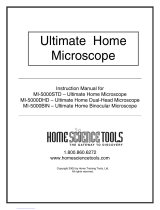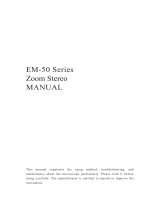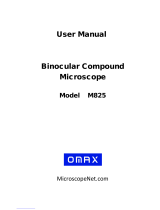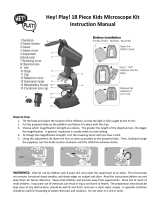Motic Panthera L Operating instructions
- Category
- Microscopes
- Type
- Operating instructions
This manual is also suitable for

WWW.MOTIC.COM
MOTIC HONG KONG LIMITED
Panthera Series
Scientific Instrument
Operation Manual
If the equipment is used in a manner
not specified by the manufacturer,
the protection provided by the
equipment may be impaired.
Note
If the equipment is used in a manner
not specified by the manufacturer,
the protection provided by the
equipment may be impaired.
Note
The clear knowledge of this Instruction Manual is needed to operate Motic Panthera Series
Microscopes at maximum performance and to ensure safety at all specified operations.
Please familiarize yourself with the use of this microscope and pay special attention to the
safety hints given in this manual. This Document is not subject of a update routine, please
download a newer version from the Motic website, if needed. Keep this instruction manual in
reach and easily accessible for future user reference. All Specifications, Illustrations and
items in this Manual are subject to changes. Forwarding, duplication or use in other
communication of this
E250223

1
English:
Please familiarize yourselves with the Instruction Manual provided in English language. Other
Language versions are available as download on Motic web services under the Address:
http://www.motic.com/Panthera/Panthera_Eng_OP.zip

2
TABLE OF CONTENTS
1. Genral notes on instrument safety 5
1.1 General safety notes and Instruction 5
1.2 Instrument safety, FCC and EMC conformity 6
1.3 Transporting, unpacking, storage of the Instrument 7
1.4 Instrument Disposal 7
1.5 Use of the Instrument 7
1.6 Intended use of the Microscope 9
1.7 Instrument warranty 9
2. Nomenclature 10
2.1 Panthera S 10
2.2 Panthera U / C / L / HD 11
3. Setting up the instrument 14
3.1 Operating environment 14
4. Assembling the microscope 17
4.1 Verifying input voltage 17
4.2 Illumination 17
4.2.1 Halogen bulb 17
4.2.2 LED 17
4.3 Stage 17
4.3.1 For Panthera S 17
4.3.2 For Panthera E / U / C / L / HD 18
4.4 Specimen holder 19
4.5 Objectives 19
4.6 Condenser (For Panthera L / HD) 19
4.7 Eyepiece tube 20
4.8 Eyepieces 20
4.9 Filters 20
4.10 Power cord 21

3
5. Digital parts (setup and operation) 22
5.1 How to use QR-Link (For Panthera L / HD) 22
5.2 ImagingOnDevice 23
5.2.1 Panthera Series Backside Connection Panel 23
5.3 TeachingOnDevice (Panthera C / HD) 24
5.3.1 Panthera ImagingOnDevice realtime sharing ImagingOnDevice with QR-Link clients 25
5.3.2 ImageRecall 25
6. Usage of microscope components 26
6.1 Coarse and fine focusing 26
6.2 Coarse focus torque adjustment 26
6.3 Coarse focus quick stop 27
6.4 Stage upper limit stop adjustment 27
6.5 Interpupillary distance adjustment 28
6.6 Diopter adjustment 29
6.7 Adjustment of Brightfield (Panthera C / L) 30
6.7.1 Full Kohler Illumination 30
6.8 Use of aperture diaphragm 31
6.9 Use of field diaphragm (For Panthera C / L only) 31
6.10 Brightness and contrast adjustment 31
6.11 Illumination brightness adjustment 32
6.11.1 Panthera S / E / C 32
6.11.2 Panthera U / L / HD 32
6.12 Restore factory default for intensity (For Panthera U / L / HD only) 32
6.13 Standby mode (For Panthera U / L / HD only) 33
6.14 Adjust the Epi-illuminatioin intensity and transmitted illumination (Panthera U / L / HD only) 33
7. Photomicrographic procedure 34
8. Using oil immersion objectives 35

4
9. Care and maintenance 36
9.1 Do not disassemble 36
9.2 Cleaning the microscope 36
9.2.1 Lenses and filters 36
9.2.2 Cleaning of painted or plastic components 36
9.3 Disinfecting the Microscope 36
9.4 When not in use 36
9.5 Bulb replacement 37
9.5.1 Replacing the 6V 30W halogen module or the two different LED module 37
(For Panthera C / L / HD)
9.5.2 Electrical Specifications 38
10. Troubleshooting table 39
10.1 Optical 39
10.2 Electrical 40
11. Selection Of The Power Supply Cord 41
Microscope terminology 43

5
1.GENRAL NOTES ON INSTRUMENT SAFETY
1.1 General safety notes and Instruction
Please familiarize yourself with this Operation Manual before starting to use the Instrument.
In case additional information or support is needed, please contact Motic after sales Service.
To ensure safe operation and optimal function of the Instrument, strictly observe the precautions and
warnings given in this Operation manual.
Please observe the following indicators:
CAUTION, Risk of Danger
This symbol indicates a possible hazard to the user of the instrument.
CAUTION, Risk of Dangerous heat
This symbol indicates a possible hazard to the user of the instrument.
CAUTION, Risk of Electrical Danger
Disconnect the plug-in power unit from line power before opening the Instrument.
INFO
This symbol refers to a useful information or hint.
Disposal
This symbol refers you a advice that must be observed under all circumstances
Instrument ON
This symbol refers to the switched on (electrical system active) status of the
instrument
Instrument OFF
This symbol refers to the switched off (electrical system inactive) status of the
instrument
Risk of Dangerous Electrical Current
This symbol refers to potential hazardous electrical voltage/current and must be
observed at all circumstances!

6
1.2 Instrument safety, FCC and EMC conformity
This Instrument has been designed, produced and tested in compliance with required safety standards
and regulations. UL, CE, FCC, EMC
“Safety of equipment used for measurement control and laboratory use”
Panthera Microscope Series Products are in conformity with the requirements of the CE
Directive 98/79/EC Annex 1 and carries the CE mark accordingly.
Conform to Class B Noise immunity is in compliance with EN 61326 and EMC and
Radio-noise suppression is in compliance with EN 5501 1
The instruments listed in this document are disposed of in compliance with WEEE Directive
2002/96/EC.
Lamp bulbs, LED Modules, lamphouses and Lampdrawers become very hot during and after a
period of operation. Risk of burn – Do not touch the lamp during or immediately after period of
operation.
Don’t pick the microscope up from the bottom during equipment operation.
Proper handling of the microscope will ensure years of trouble free service.
If repair become necessary, please contact your Motic agency or our Technical Service directly.

7
1.3 Transporting, unpacking, storage of the Instrument
Please observe and follow the safety notes for transportation, unpacking and storage
given in this document:
● The microscope is delivered as set, packed into commercial standard plastic and
cardboard packaging; Please re-use the original packaging only for any transportation.
● It is advised to keep and use the original packaging for longer storage or return to the
manufacturer to avoid losing the warranty.
● At receiving and unpacking the equipment, please verify that all parts specified on the
delivery note are present.
● Keep Transport and storage temperatures as specified in this Manual.
● Set the microscope up on a stable worktable with solid and smooth top surface suitable for
Instrument use.
● Do not touch optical surfaces.
1.4 Instrument Disposal
Please observe the following safety notes for the disposal of the microscope:
Defective Instruments, accessories and consumables should be disposed in compliance with
the provisions of the local law.
1.5 Use of the Instrument
The microscope Instrument as well its accessories must not be used for microscopic techniques or
purposes other than those described in this Operating Manual.
Please always observe the following safety notes when using the microscope:
Motic cannot assume any liability for other applications then the intended use, including the
included modules and components. This includes to service or repair work that is not carried
out by authorized Motic service personnel. In case of non-compliance, all warranty claims and
liabilities shall be forfeited.
The microscope Instrument should only be operated by trained personnel who are familiar with
this Operation Manual and therefore aware of the possible dangers involved.

8
This Microscope is a high-precision instrument that can be impaired in its performance or even
be destroyed when handled improperly.
This Instrument is equipped with a build in power supply allowing electric-net voltages to be
used in the range between 100 - 240 V ± 10%, 50/60 Hz. In case of any irregularity on the
electrical system observed, please switch of the Instrument, keep it safe guarded and consult
the Motic after sales service.
Please only use rated Power cords as described in the Appendix of this Document
Always disconnect the power cable, before opening the instrument and changing the lamp or
LED source.
Wait for the lamp to cool down before replacing it and do not touch the new bulb.
The instrument may only be opened by qualified Motic service staff.
The operation of the instrument in explosion-risk environments is not allowed.
Immersion Oil can be harmful. Please only use Motic immersion Oil and follow the safety
Instructions given. I
mmersion oil is to be used for Microscope application only! Please avoid skin
contact or swallow or any other use then the intended.

9
1.6 Intended use of the Microscope
This Microscope is an optical instrument that has been designed to be used to observe and document
magnified images of specimens in teaching, routine and research applications.
Do not use this instrument for any other purpose than its intended use.
This Instrument complies with the requirements of directive 98/79/EG concerning in-vitro
diagnostic medical devices. CE marking shows the conformity to the directive.
NOTE: This Instrument has been tested and found to comply with the limits for a Class A
digital device, pursuant to Part 15 of the FCC Regulations. These limits are designed to
provide protection against harmful interference during operation in a commercial environment.
This equipment uses and generates frequencies and energy, if not properly installed in
accordance with the instruction manual, those may cause interference to radio
communications. Operation of this Instrument in a residential area is not permitted.
FCC WARNING: Changes or modifications would void the Instruments FCC compliance and is
therefore not permitted.
1.7 Instrument warranty
The Instrument should only be used for microcopy applications mentioned and instructed in this
operation manual. Please note the following information on the instruments warranty.
● If possible defects Motic must be notified immediately and steps be taken to minimize damage.
● If notified of such a defect Motic will evaluate the defect and if within warrant, rectify it at his
discretion, either by repairing the instrument or by delivering a replacement.
● Natural wear, or defects caused by improper use are not covered by the Instrument warranty.
● Motic shall not be liable for damage caused by faulty operation, negligence or tampering with the
Instrument.
● Altering or tampering of the instrument shall lead to a forfeit of all warranty claims

10
2.NOMENCLATURE
2.1 Panthera S (Binocular Version)

11
2.2 Panthera U / C / L (Binocular Version) / HD

12
Full Kohler Illumination Fixed Kohler Illumination
Objective Lenses:
Magnification N.A. W.D (mm)
Plan UC 2X 0.05 7.2
Plan UC 4X 0.1 30.5
Plan UC 10X 0.25 17.4
Plan UC 20X 0.45 0.8
Plan UC 40X 0.65 0.6
Plan UC 60X 0.8 0.35
Plan UC 100X/1.25 Oil 1.25 0.16
Plan UC 100X/0.8 0.8 2

13
Working distance WD: The distance from the cover glass top surface to the nearest point of the
objective.
Numerical aperture NA: The NA is a performance indicator. The higher NA, the higher the resolving
power.
It describes the ability of the lens to collect light under steep entry angles.
Resolution: The ability to differentiate two points, or minimum distance under which
two points can be differentiated.
Focal depth: The area along the optical axis where a focused image appears to be sharp.
If the aperture iris diaphragm is stopped down, the focal depth becomes
bigger. As greater the NA of an objective, as shorter the focal depth.
Field number: A value that indicates the diameter of the image of the field diaphragm that
is formed by the lens in front of it in mm.
Field of view: The actual size of the field of view in millimeters in the Eyepiece.
Total magnification: Objective magnification multiplied by the eyepiece magnification.

14
3.SETTING UP THE INSTRUMENT
Avoid placing the instrument in locations exposed to direct sunlight, dust, vibration, high temperature,
high humidity and where it is difficult to unplug the power supply cord.
3.1 Operating environment
● Indoor use
● Altitude: Max 2000 meters
● Ambient temperature: 15°C to 35°C
● Maximum relative humidity: 75% for temperature up to 31°C decreasing linearly to 50% relative
humidity at 40°C
● Supply voltage fluctuations: Not to exceed ±10% of the normal voltage.
● Pollution degree: 2 (in according with IEC60664)
● Installation / Overvoltage category: 2 (in according with IEC60664)
● Air pressure of 75kPa to 106 kPa
● Avoid frost, dew, percolating water, and rain.
Panthera School
■ PowerOnDevice (USB Camera Power, USB Powerpack)
■ Cabinet size bino, trino head
■ Camera Power devise
Panthera E
■ PowerOnDevice (USB Camera Power, USB Powerpack)
■ Cabinet size bino, trino head
■ Camera Power devise
■ Rackless Stage

15
Panthera University
■ Light Tracer, digital light control
■ Bino, trino, Plan UC optic
■ Rackless Stage
Panthera Classic
■ Bino, trino, Plan UC optic
■ Rackless Stage
Panthera LifeScience
■ Light Tracer, digital light control
■ ImagingOnDevice
■ QR-Link
■ ImageRecall

16
Panthera HD
■ SmartLight brightness control
■ ImagingOnDevice
■ QR-Link
■ ImageRecall
■ Similar to Panthera L, without Eyepiece
Please familiarize yourself with the instructions given in this Operation Manual.
In case of unresolved questions, please contact Motic after sales Service or consult Motic
Webservices for further instructions.

17
4.ASSEMBLING THE MICROSCOPE
4.1 Verifying input voltage
● The automatic voltage selection works with a broad range of settings, please check the power
rating of your country is admitted before the use of the Instrument under chapter specification.
However, always use a power cord that is rated for the voltage used in your area and that has
been approved to meet local safety standards. Using the wrong power cord could cause fire
or equipment damage.
● If using an extension cord, use only a power supply cord with a protective earth (PE) wire.
● In order to prevent electric shock, always turn the power switch on the power supply off before
connecting the power cord.
4.2 Illumination
4.2.1 Halogen bulb
● The quartz halogen bulb, provides a nearly complete vis light specimen with high luminance and
natural temperature.
● The halogen bulb maintains the same level of brightness and color temperature through its full
lifespan.
4.2.2 LED
● LED is more economical and environmental friendly and combines the advantages of low heat and
long life span. There are two different color temperature available. High contrast blue/warm color
temperature.
4.3 Stage
4.3.1 For Panthera S
● Remove specimen holder for fast hand scanning
of slides.
● Left-handed and right-handed operation stages are
available for option.
(Fig.1)

18
4.3.2 For Panthera E / U / C / L / HD
Panthera E, U, C, L, HD Stage is fitted with a Rackless providing more clearance for the user and
avoid the possibility to scratch the users hand.
● Remove specimen holder for fast hand scanning of slides.
● Left-handed and right-handed operation stages are available for option.
Left hand operation stages is available for option. It should be used with the short stage knob for
avoiding to interfere the fine focus knob.
(Fig.2)
● Stage drive Torque adjustment (Optional feature)
The torque of the y-axis and x-axis travel knobs can be adjusted by torque adjusting knobs.
For y-axis to (+) increase or (-) decrease the torque,
turn Knob Y while holding A
For x-axis to (+) increase or (-) decrease the torque,
turn Knob X while holding B

19
4.4 Specimen holder
● Attach the specimen holder, using the two mounting holes.
4.5 Objectives
● Lower the stage completely. Screw the objectives into the revolving nosepiece so that clockwise
rotation of the nosepiece brings the next higher magnification objective into position.
(Fig.3)
4.6 Condenser
● Raise the stage by turning the coarse focus knob.
● Completely lower the condenser carrier by turning the condenser focus knob. (Fig.4-1)
● Insert the condenser into the dovetail mount with aperture scale facing forward towards the user.
Secure it with the condenser clamp screw. (Fig.4-2)
● Turn the condenser focus knob to raise the condenser as far as it will go. (Fig.4-1)
(Fig.4-1) (Fig.4-2)
Page is loading ...
Page is loading ...
Page is loading ...
Page is loading ...
Page is loading ...
Page is loading ...
Page is loading ...
Page is loading ...
Page is loading ...
Page is loading ...
Page is loading ...
Page is loading ...
Page is loading ...
Page is loading ...
Page is loading ...
Page is loading ...
Page is loading ...
Page is loading ...
Page is loading ...
Page is loading ...
Page is loading ...
Page is loading ...
Page is loading ...
Page is loading ...
Page is loading ...
Page is loading ...
-
 1
1
-
 2
2
-
 3
3
-
 4
4
-
 5
5
-
 6
6
-
 7
7
-
 8
8
-
 9
9
-
 10
10
-
 11
11
-
 12
12
-
 13
13
-
 14
14
-
 15
15
-
 16
16
-
 17
17
-
 18
18
-
 19
19
-
 20
20
-
 21
21
-
 22
22
-
 23
23
-
 24
24
-
 25
25
-
 26
26
-
 27
27
-
 28
28
-
 29
29
-
 30
30
-
 31
31
-
 32
32
-
 33
33
-
 34
34
-
 35
35
-
 36
36
-
 37
37
-
 38
38
-
 39
39
-
 40
40
-
 41
41
-
 42
42
-
 43
43
-
 44
44
-
 45
45
-
 46
46
Motic Panthera L Operating instructions
- Category
- Microscopes
- Type
- Operating instructions
- This manual is also suitable for
Ask a question and I''ll find the answer in the document
Finding information in a document is now easier with AI
Related papers
-
Motic PANTHERA CLOUD User manual
-
Motic B1 Elite Series User manual
-
Motic BA210 and BA310 Digital Microscopes User manual
-
Motic AE21 User manual
-
Motic SFC3 Series User manual
-
Motic PM Series User manual
-
Motic RED100 Series User manual
-
Motic SILVER LINE User manual
-
Motic PM Series User manual
-
Motic SFC100 Series User manual
Other documents
-
Carson MM-200 Micro Max LED Lighted Zoom Microscope User manual
-
Olympus CX22LED Instructions Manual
-
Bresser 5914170 Owner's manual
-
 HomeScienceTools MI-5000STD User manual
HomeScienceTools MI-5000STD User manual
-
 Meiji Techno EM-50 Owner's manual
Meiji Techno EM-50 Owner's manual
-
Celestron 44110 User manual
-
Celestron 52348 Installation guide
-
 Omax M825 User manual
Omax M825 User manual
-
 Hey! Play! HW3300007 Operating instructions
Hey! Play! HW3300007 Operating instructions
-
National 157 User Instruction

















































